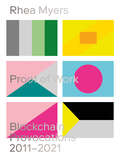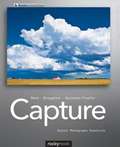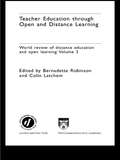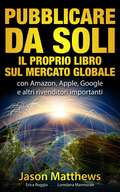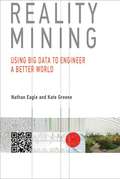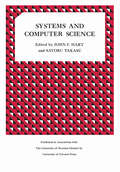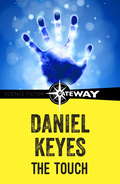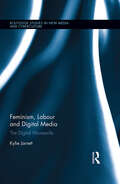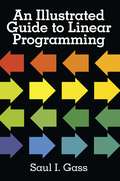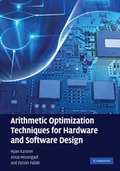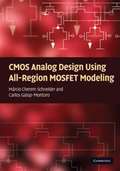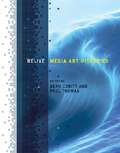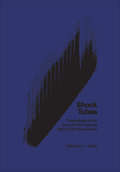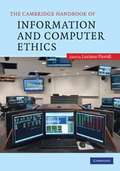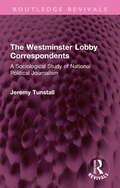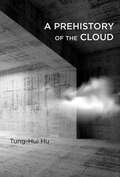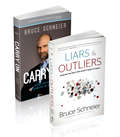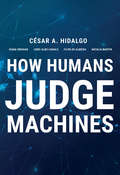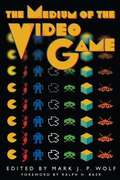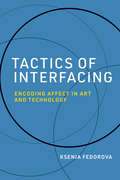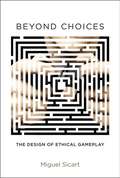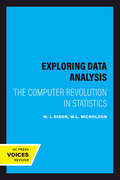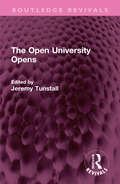- Table View
- List View
Infusing Real World Experiences into Engineering Education
by National Academies of EngineeringThe aim of this report is to encourage enhanced richness and relevance of the undergraduate engineering education experience, and thus produce better-prepared and more globally competitive graduates, by providing practical guidance for incorporating real world experience in US engineering programs. The report, a collaborative effort of the National Academy of Engineering (NAE) and Advanced Micro Devices, Inc. (AMD), builds on two NAE reports on The Engineer of 2020 that cited the importance of grounding engineering education in real world experience. This project also aligns with other NAE efforts in engineering education, such as the Grand Challenges of Engineering, Changing the Conversation, and Frontiers of Engineering Education. This publication presents 29 programs that have successfully infused real world experiences into engineering or engineering technology undergraduate education. The Real World Engineering Education committee acknowledges the vision of AMD in supporting this project, which provides useful exemplars for institutions of higher education who seek model programs for infusing real world experiences in their programs. The NAE selection committee was impressed by the number of institutions committed to grounding their programs in real world experience and by the quality, creativity, and diversity of approaches reflected in the submissions. A call for nominations sent to engineering and engineering technology deans, chairs, and faculty yielded 95 high-quality submissions. Two conditions were required of the nominations: (1) an accredited 4-year undergraduate engineering or engineering technology program was the lead institutions, and (2) the nominated program started operation no later than the fall 2010 semester. Within these broad parameters, nominations ranged from those based on innovations within a single course to enhancements across an entire curriculum or institution. Infusing Real World Experiences into Engineering Education is intended to provide sufficient information to enable engineering and engineering technology faculty and administrators to assess and adapt effective, innovative models of programs to their own institution's objectives. Recognizing that change is rarely trivial, the project included a brief survey of selected engineering deans concern in the adoption of such programs.
Proof of Work: Blockchain Provocations 20112021 (Urbanomic / Art Editions)
by Rhea MyersA beautifully produced anthology of crypto-artist, writer, and hacker Rhea Myers's pioneering blockchain art, along with a selection of her essays, reviews, and fictions.DAO? BTC? NFT? ETH? ART? WTF? HODL as OG crypto-artist, writer, and hacker Rhea Myers searches for faces in cryptographic hashes, follows a day in the life of a young shibe in the year 2032, and patiently explains why all art should be destructively uploaded to the blockchain. Now an acknowledged pioneer whose work has graced the auction room at Sotheby&’s, Myers embarked on her first art projects focusing on blockchain tech in 2011, making her one of the first artists to engage in creative, speculative, and conceptual engagements with "the new internet." Proof of Work brings together annotated presentations of Myers&’s blockchain artworks along with her essays, reviews, and fictions—a sustained critical encounter between the cultures and histories of the artworld and crypto-utopianism, technically accomplished but always generously demystifying and often mischievous. Her deep understanding of the technical history and debates around blockchain technology is complemented by a broader sense of the crypto movement and the artistic and political sensibilities that accompanied its ascendancy. Remodeling the tropes of conceptual art and net.art to explore what blockchain technology reveals about our concepts of value, culture, and currency, Myers&’s work has become required viewing for anyone interested in the future of art, consensus, law, and collectivity.
Capture
by Glenn Rand Chris Broughton Amanda Quintenz-FiedlerIn film-based photographic education, strong programs and writings have placed great emphasis on making a negative. But to get to the negative, good exposure is required. The beginning of the photographic process significantly affects the final outcome of an image - a fact that has not changed with digital photography. Capture: Digital Photography Essentials concentrates on photography from a digital-capture workflow point of view. The text addresses both the opportunities and limitations of digital photography, and how to work with those opportunities and around the limitations. Authors Glen Rand, Chris Broughton, and Amanda Quintenz-Fiedler discuss the digital tools that allow photographers to capture, create, and maintain high-quality digital photographs. Readers will learn to maximize the potential of their images through an understanding of the core principles and more advanced aspects of the digital photographic process. Various projects that are based on tested teaching concepts for digital photography can be found throughout the text, as well as numerous images that are both inspirational and instructional. Topics include: Digital Cameras Sensors and Lenses Basic Exposure Digital Exposure Digital Capture Workflow Image Files Parametric Editing Digital Zone System HDRI Hybrid Imaging Capture Technology
Teacher Education Through Open and Distance Learning: World review of distance education and open learning Volume 3 (World Review Of Distance Education And Open Learning Ser. #Vol. 4)
by Colin Latchem Bernadette RobinsonHow can open and distance learning and information and communications technology (ICT) provide us with more - and better - teachers?Open and distance learning is increasingly used in teacher education in developing and developed countries. It has the potential to strengthen and expand the teaching profession of the twenty-first century and to help achieve the target of education for all by 2015. Teacher Education Through Open and Distance Learning examines the case for using open and distance learning and ICT to train our educators. It describes and analyses the ways in which these methods and technologies are used for:*initial teacher training and continuing professional development*training principals and school managers*training those who provide non-formal adult and community education*communities of practice and sharing of knowledge and ideas within the teaching professionIt also discusses the policy-making, management, technology, costing, evaluation and quality assurance aspects of this work. The contributors are outstanding practitioners in the field. The first review in over a decade, Teacher Education Through Open and Distance Learning draws on wide-ranging and international experience to summarise the strengths and weaknesses of new approaches to the education of teachers. It offers invaluable guidance to policymakers, planners, headteachers and teachers.
Pubblicare da soli il proprio libro sul mercato globale
by Jason Matthews Erica Roggio e Loredana MarmoraleHai scritto un libro? Vuoi vendere su Amazon, Apple, Google e altri importanti rivenditori? Risparmia tempo e denaro vendendo e-book online con questa semplice guida all'auto-pubblicazione. Risolvi i tuoi dubbi su come preparare il tuo libro per caricarlo sulle piattaforme dei principali rivenditori. Il manuale, che include consigli per far emergere il tuo libro rispetto a tanti altri, è stato scritto da Jason Matthews, esperto di auto-pubblicazione e autore di numerose opere letterarie di narrativa e saggistica. I suoi libri sono stati tradotti in 8 lingue e i suoi corsi video sono stati seguiti da studenti di oltre 123 paesi. Preparati a raggiungere velocemente gli obiettivi di pubblicazione. Imparerai a: •formattare il tuo libro per i principali rivenditori •convertirlo in ePub in modo che sia visualizzato correttamente su tablet, smartphone e Kindle •disegnare una copertina accattivante •vendere attraverso Amazon, Apple, Google Play, Barnes & Noble, Smashwords, Kobo e altre piattaforme •utilizzare i social media in maniera intelligente (Facebook, Twitter, Google Plus, YouTube) •bloggare e creare la tua piattaforma autore •ottenere recensioni, e tanto altro ancora. Trova soluzioni per le tue esigenze di modifica, copyright, ISBN e altri requisiti, oltre alle migliori opzioni e strategie per lavorare con i professionisti. I lettori di tutto il mondo sono affamati di nuovi libri. Sei pronto a condividere il tuo? Inizia oggi!
Reality Mining
by Kate Greene Nathan EagleBig Data is made up of lots of little data: numbers entered into cell phones, addresses entered into GPS devices, visits to websites, online purchases, ATM transactions, and any other activity that leaves a digital trail. Although the abuse of Big Data -- surveillance, spying, hacking -- has made headlines, it shouldn't overshadow the abundant positive applications of Big Data. In Reality Mining, Nathan Eagle and Kate Greene cut through the hype and the headlines to explore the positive potential of Big Data, showing the ways in which the analysis of Big Data ("Reality Mining") can be used to improve human systems as varied as political polling and disease tracking, while considering user privacy.Eagle, a recognized expert in the field, and Greene, an experienced technology journalist, describe Reality Mining at five different levels: the individual, the neighborhood and organization, the city, the nation, and the world. For each level, they first offer a nontechnical explanation of data collection methods and then describe applications and systems that have been or could be built. These include a mobile app that helps smokers quit smoking; a workplace "knowledge system"; the use of GPS, Wi-Fi, and mobile phone data to manage and predict traffic flows; and the analysis of social media to track the spread of disease. Eagle and Greene argue that Big Data, used respectfully and responsibly, can help people live better, healthier, and happier lives.
Systems and Computer Science: Proceedings of a Conference held at the University of Western Ontario September 10-11, 1965
by John Hart Satoru TakasuThis book presents the papers delivered at the Conference on Systems and Computer Science held at the University of Western Ontario in September 1965. The primary purposes of the Conference were the promotion of research and the development of the teaching of computer science in Canadian universities. The papers focus attention on some of the concepts of Computer Science as a new field of study and at the same time provide a background for scientists looking at the subject for the first time. The chief developments in computer science have been concerned with the "applied" rather than the "pure" areas of the field: numerical analysis, applied statistics and operations research, and data processing. But there is something more to computers than the physical components and this book represents an attempt to correct the imbalance between "applied" and "pure" by drawing attention to certain theoretical aspects of computer and information science. Among the topics discussed are the theory of finite and infinite automata, aspects of formal language theory, heuristic and non-heuristic approaches to theorem proving and the mathematical formulation of the theory of general systems. There are also references to the problems of machine design, to software systems including higher-level languages, to multiple control computer models and to applied systems. This collection of papers will appeal first to graduate students and professors in Computer Science. It will also be of interest to computer scientists in industry and in government and university research groups and to the scientific public interested in discovering some of the principal ingredients and directions of the computer and information sciences.
The Touch
by Daniel KeyesThe ultimate 'what if' novel, from the million-copy-bestselling author of FLOWERS FOR ALGERNON: 'A masterpiece of poignant brilliance ... heartbreaking' GuardianKaren and Barney Stark should never have married. Childless, uncomfortable and incompatible, their marriage has not been a success, and the lack of a child only makes the tension between them worse. And living their lives to the beat of a fertility clock only adds to the increasingly volatile atmosphere.When an incident at Barney's workplace causes them both to be unknowingly contaminated with radioactive dust, they also become pariahs - in their neighbourhood and with their families. But things are only going to get worse. Karen discovers she is pregnant and as their closest friends become frightened enemies, the dream of becoming parents turns into a nightmare...
Feminism, Labour and Digital Media: The Digital Housewife (Routledge Studies in New Media and Cyberculture)
by Kylie JarrettThere is a contradiction at the heart of digital media. We use commercial platforms to express our identity, to build community and to engage politically. At the same time, our status updates, tweets, videos, photographs and music files are free content for these sites. We are also generating an almost endless supply of user data that can be mined, re-purposed and sold to advertisers. As users of the commercial web, we are socially and creatively engaged, but also labourers, exploited by the companies that provide our communication platforms. How do we reconcile these contradictions? Feminism, Labour and Digital Media argues for using the work of Marxist feminist theorists about the role of domestic work in capitalism to explore these competing dynamics of consumer labour. It uses the concept of the Digital Housewife to outline the relationship between the work we do online and the unpaid sphere of social reproduction. It demonstrates how feminist perspectives expand our critique of consumer labour in digital media. In doing so, the Digital Housewife returns feminist inquiry from the margins and places it at the heart of critical digital media analysis.
An Illustrated Guide to Linear Programming
by Dr Saul I. Gass"I would not hesitate to recommend the book." -- Industrial Engineering. Entertaining, nontechnical introduction covers basic concepts of linear programming and its relationship to operations research; geometric interpretation and problem solving, solution techniques, network problems, much more. Appendix offers precise statements of definitions, theorems, and techniques, additional computational procedures. Only high-school algebra needed. Bibliography.
Arithmetic Optimization Techniques for Hardware and Software Design
by Ryan Kastner Anup Hosangadi Farzan FallahObtain better system performance, lower energy consumption, and avoid hand-coding arithmetic functions with this concise guide to automated optimization techniques for hardware and software design. High-level compiler optimizations and high-speed architectures for implementing FIR filters are covered, which can improve performance in communications, signal processing, computer graphics, and cryptography. Clearly explained algorithms and illustrative examples throughout make it easy to understand the techniques and write software for their implementation. Background information on the synthesis of arithmetic expressions and computer arithmetic is also included, making the book ideal for new-comers to the subject. This is an invaluable resource for researchers, professionals, and graduate students working in system level design and automation, compilers, and VLSI CAD.
CMOS Analog Design Using All-Region MOSFET Modeling
by Márcio Cherem Schneider Carlos Galup-MontoroComparing bipolar technology briefly but otherwise not considering it, Schneider and Galup-Montoro (both electrical engineering, Federal U. of Santa Catarina, Brazil) focus on analog MOS (metal-oxide-semiconductor) circuits at the transistor level. They use an accurate but simple MOS transistor model for design, in order to reduce the distance between hand design and simulation results. Instead of the usual separate analytical formulas for the strong-inversion and weak-inversion operation regions of a building block, they provide simple formulas that are valid in all operation regions, including moderate inversion. The unified design is particularly suitable for analog design in advanced complementary MOS (CMOS) technologies. Among their topics are temporal and spatial fluctuations in MOSFETs (MOS field-effect-transistors), current mirrors, basic gain stages, operational amplifiers, and fundamentals of sampled-data circuits. The text is suitable for analog CMOS design courses. Annotation ©2010 Book News, Inc. , Portland, OR (booknews. com)
Relive: Media Art Histories
by Paul Thomas Sean CubittIn "Relive," leading historians of the media arts grapple with this dilemma: how can we speak of "new media" and at the same time write the histories of these arts? These scholars and practitioners redefine the nature of the field, focusing on the materials of history -- the materials through which the past is mediated. Drawing on the tools of media archaeology and the history and philosophy of media, they propose a new materialist media art history. The contributors consider the idea of history and the artwork's moment in time; the intersection of geography and history in regional practice, illustrated by examples from eastern Europe, Australia, and New Zealand; the contradictory scales of evolution, life cycles, and bodily rhythms in bio art; and the history of the future -- how the future has been imagined, planned for, and established as a vector throughout the history of new media arts. These essays, written from widely diverse critical perspectives, capture a dynamic field at a moment of productive ferment. ContributorsSusan Ballard, Brogan Bunt, Andr's Burbano, Jon Cates, John Conomos, Martin Constable, Sean Cubitt, Francesca Franco, Darko Fritz, Zhang Ga, Monika Gorska-Olesinska, Ross Harley, Jens Hauser, Stephen Jones, Douglas Kahn, Ryszard W. Kluszczynski, Caroline Seck Langill, Leon Marvell, Rudy Rucker, Edward A. Shanken, Stelarc, Adele Tan, Paul Thomas, Darren Tofts, Joanna Walewska
Shock Tubes: Proceedings of the Seventh International Shock Tube Symposium held at University of Toronto, Toronto, Canada 23-25 June 1969
by Irving Israel GlassThis volume contains the proceedings of a symposium held at the University of Toronto in June 1969. The symposium consisted of six sessions; each containing an invited paper, followed by six contributed papers reporting on recent, relevant research and development. The topics are: a review of research problems in basic shock tube flows and the possibilities for the shock tube in the future; driving techniques; explosive drivers; theoretical and experimental research in electromagnetic shock tubes; chemical kinetics and spectroscopy; and a review of shock tube diagnostics, instrumentation and fundamental data as well as the measurement of physical quantities.
The Cambridge Handbook of Information and Computer Ethics
by Luciano FloridiInformation and Communication Technologies (ICTs) have profoundly changed many aspects of life, including the nature of entertainment, work, communication, education, healthcare, industrial production and business, social relations and conflicts. They have had a radical and widespread impact on our moral lives and hence on contemporary ethical debates. The Cambridge Handbook of Information and Computer Ethics provides an ambitious and authoritative introduction to the field, with discussions of a range of topics including privacy, ownership, freedom of speech, responsibility, technological determinism, the digital divide, cyber warfare, and online pornography. It offers an accessible and thoughtful survey of the transformations brought about by ICTs and their implications for the future of human life and society, for the evaluation of behaviour, and for the evolution of moral values and rights. It will be a valuable book for all who are interested in the ethical aspects of the information society in which we live.
The Westminster Lobby Correspondents: A Sociological Study of National Political Journalism (Routledge Revivals)
by Jeremy TunstallThe Westminster Lobby correspondents have a special place in both the politics and the mass media of Britain. These journalists dominate the behind-the-scenes reporting of British national politics. In this book, originally published in 1970, Jeremy Tunstall presents the first systematic social science study of the uniquely British phenomenon of Lobby correspondents.The study includes data collected from interviews with the national Lobby correspondents, who also completed lengthy questionnaires. It contains evidence of their careers, political opinions, pay, working conditions, relationships with their employing news organization and political news sources, and on the way in which the correspondents both compete with, and exchange information with, each other. As well as this fascinating empirical data, the book offers an important contribution to the sociology of politics and the mass media, and to the study of ‘organizational intelligence’ and the sociology of occupations.There had long centred upon the Lobby correspondents many myths and misconceptions, which Jeremy Tunstall effectively demolishes. (The so-called ‘Lobby rules’ were here published for the first time.) Other real dilemmas are, however, revealed: the competing demands of publicity and secrecy; the dilemmas of British politics in which basic principles – such as Parliamentary supremacy and Cabinet secrecy – are daily breached, not only by the correspondents, but also by leading politicians; and the problems of a system of political communication whose obsession with daily news values is so similar to official and academic contributions. With media and politics still very much linked today, this reissue can be read and enjoyed in its historical context.
A Prehistory of the Cloud
by Tung-Hui HuWe may imagine the digital cloud as placeless, mute, ethereal, and unmediated. Yet the reality of the cloud is embodied in thousands of massive data centers, any one of which can use as much electricity as a midsized town. Even all these data centers are only one small part of the cloud. Behind that cloud-shaped icon on our screens is a whole universe of technologies and cultural norms, all working to keep us from noticing their existence. In this book, Tung-Hui Hu examines the gap between the real and the virtual in our understanding of the cloud. Hu shows that the cloud grew out of such older networks as railroad tracks, sewer lines, and television circuits. He describes key moments in the prehistory of the cloud, from the game "Spacewar" as exemplar of time-sharing computers to Cold War bunkers that were later reused as data centers. Countering the popular perception of a new "cloudlike" political power that is dispersed and immaterial, Hu argues that the cloud grafts digital technologies onto older ways of exerting power over a population. But because we invest the cloud with cultural fantasies about security and participation, we fail to recognize its militarized origins and ideology. Moving between the materiality of the technology itself and its cultural rhetoric, Hu's account offers a set of new tools for rethinking the contemporary digital environment.
Bruce Schneier on Trust Set
by Bruce SchneierSave almost 25% on this two-book set from Bruce Schneier covering issues of social trust and securityThis set includes two books from security expert Bruce Schneier, Liars and Outliers: Enabling the Trust that Society Needs to Thrive and Carry On: Sounds Advice from Schneier on Security. In Liars and Outliers, Schneier covers the topic of trust in society and how issues of trust are critical to solving problems as diverse as corporate responsibility, global warming, and the political system. Insightful and entertaining, the weaves together ideas from across the social and biological sciences to explain how society induces trust and how trust facilitates and stabilizes society.Carry On features more than 140 articles by Schneier, including more than twenty unpublished articles, covering such security issues as crime and terrorism, human security, privacy and surveillance, the psychology of security, security and technology, travel and security, and more.A two-book set from a renowned author, technologist, and security expertCovers such current topics as the Internet as surveillance state, Chinese cyberattackes, privacy and social networking, aviation security, and moreIdeal for IT professionals, security and networking engineers, hackers, consultants, and technology vendorsTogether, these two books offer deep and practical insight into a wide range of security topics for professionals in technology fields, as well as anyone interested in the larger philosophical issues of security.
Das Buch zu E-Books
by Andy Artmann Florian RudtSie fragen sich, ob E-Books etwas für Sie sind? Sie wollen einen E-Reader anschaffen? Sie möchten Ihr iPad oder Ihren Tablet PC zum Lesen nutzen? Sie fragen sich, wo Sie digitalen Lesestoff kaufen oder E-Books sogar kostenlos bekommen können? Sie möchten verstehen, was EPUBs von PDFs unterscheidet? Das Buch zu E-Books bietet einen Einstieg in die Welt der digitalen Bücher. Machen Sie sich ein Bild über die Vor- und Nachteile, die neuen Möglichkeiten und Einschränkungen des digitalen Lesens. Die Autoren -- seit vielen Jahren in der Welt der Bücher und inzwischen auch der E-Books zuhause -- unterstützen Sie mit praktischen Anleitungen und Tipps bei Ihren ersten Schritten. Sie beantworten zentrale Fragen wie: - Auf welchen Geräten kann ich E-Books lesen und was passt am besten zu meinen Bedürfnissen? - Welche gut sortieren E-Book-Shops gibt es und wo finde ich gemeinfreie E-Books, kostenlos und ganz legal? - Mit welchen Apps bzw. Programmen kann ich meine E-Books lesen und wie benutze ich sie? - Apple und Amazon gelten als geschlossene Welten - was muss ich beachten? - E-Books nicht kaufen, sondern ausleihen - wo und wie geht das? - EPUB oder PDF, Bücher mit und ohne DRM - was bedeutet das praktisch?
How Humans Judge Machines
by Cesar A. Hidalgo Diana Orghiain Jordi Albo Canals Filipa De Almeida Natalia MartinHow people judge humans and machines differently, in scenarios involving natural disasters, labor displacement, policing, privacy, algorithmic bias, and more.How would you feel about losing your job to a machine? How about a tsunami alert system that fails? Would you react differently to acts of discrimination depending on whether they were carried out by a machine or by a human? What about public surveillance? How Humans Judge Machines compares people's reactions to actions performed by humans and machines. Using data collected in dozens of experiments, this book reveals the biases that permeate human-machine interactions. Are there conditions in which we judge machines unfairly? Is our judgment of machines affected by the moral dimensions of a scenario? Is our judgment of machine correlated with demographic factors such as education or gender? César Hidalgo and colleagues use hard science to take on these pressing technological questions. Using randomized experiments, they create revealing counterfactuals and build statistical models to explain how people judge artificial intelligence and whether they do it fairly. Through original research, How Humans Judge Machines bring us one step closer tounderstanding the ethical consequences of AI.
The Medium of the Video Game
by Mark J. P. WolfOver a mere three decades, the video game has become the entertainment medium of choice for millions of people, who now spend more time in the interactive virtual world of games than they do in watching movies or even television. The release of new games or game-playing equipment, such as the PlayStation 2, generates great excitement and even buying frenzies. Yet, until now, this giant on the popular culture landscape has received little in-depth study or analysis. In this book, Mark J. P. Wolf and four other scholars conduct the first thorough investigation of the video game as an artistic medium. The book begins with an attempt to define what is meant by the term ""video game"" and the variety of modes of production within the medium. It moves on to a brief history of the video game, then applies the tools of film studies to look at the medium in terms of the formal aspects of space, time, narrative, and genre. The book also considers the video game as a cultural entity, object of museum curation, and repository of psychological archetypes. It closes with a list of video game research resources for further study.
Tactics of Interfacing: Encoding Affect in Art and Technology (Leonardo)
by Ksenia FedorovaHow digital technologies affect the way we conceive of the self and its relation to the world, considered through the lens of media art practices.In Tactics of Interfacing, Ksenia Fedorova explores how digital technologies affect the way we conceive of the self and its relation to the world. With the advent of ubiquitous computing, the self becomes an object of technological application, increasingly defined by data received from tracking technologies. Subtly, these technologies encourage versions of ourselves that are easier to interpret computationally. Fedorova views these shifts in self-perception through the lens of contemporary media art practices, examining a range of artistic tactics that enable embodied and intimate experiences of machinic operations on our lives.
Beyond Choices
by Miguel SicartToday's blockbuster video games -- and their never-ending sequels, sagas, and reboots -- provide plenty of excitement in high-resolution but for the most part fail to engage a player's moral imagination. In Beyond Choices, Miguel Sicart calls for a new generation of video and computer games that are ethically relevant by design. In the 1970s, mainstream films -- including The Godfather, Apocalypse Now, Raging Bull, and Taxi Driver -- filled theaters but also treated their audiences as thinking beings. Why can't mainstream video games have the same moral and aesthetic impact? Sicart argues that it is time for games to claim their place in the cultural landscape as vehicles for ethical reflection.Sicart looks at games in many manifestations: toys, analog games, computer and video games, interactive fictions, commercial entertainments, and independent releases. Drawing on philosophy, design theory, literary studies, aesthetics, and interviews with game developers, Sicart provides a systematic account of how games can be designed to challenge and enrich our moral lives. After discussing such topics as definition of ethical gameplay and the structure of the game as a designed object, Sicart offers a theory of the design of ethical game play. He also analyzes the ethical aspects of game play in a number of current games, including Spec Ops: The Line, Beautiful Escape: Dungeoneer, Fallout New Vegas, and Anna Anthropy's Dys4Ia. Games are designed to evoke specific emotions; games that engage players ethically, Sicart argues, enable us to explore and express our values through play.
Exploring Data Analysis: The Computer Revolution in Statistics
by W. J. Dixon W. L. Nicholson xxx National Bureau of StandardsThis title is part of UC Press's Voices Revived program, which commemorates University of California Press’s mission to seek out and cultivate the brightest minds and give them voice, reach, and impact. Drawing on a backlist dating to 1893, Voices Revived makes high-quality, peer-reviewed scholarship accessible once again using print-on-demand technology. This title was originally published in 1974.This title is part of UC Press's Voices Revived program, which commemorates University of California Press’s mission to seek out and cultivate the brightest minds and give them voice, reach, and impact. Drawing on a backlist dating to 1893, Voices Revived</DIV
The Open University Opens (Routledge Revivals)
by Jeremy TunstallStill going strong today, The Open University, Britain’s national correspondence – TV – radio University, excited much controversy when it first opened and in 1973 awarded its first degrees. With its adult, part-time students, its freedom from formal entrance qualifications, it deliberately questioned many orthodoxies of higher education at the time. Yet the OU differed so much from other universities that few outsiders grasped quite how complex, quite how revolutionary, quite how downright infuriating the OU was, or could be.Originally published in 1974, this book gives a first-hand account of what the OU was about and what it felt like to be an OU student or lecturer. The articles in the collection – edited by Jeremy Tunstall, himself on the OU staff – include contributions from outside observers, from OU staff, and from OU students. This is an unofficial yet informed and lively account of what it felt like in 1974, and what it felt like in the early days, to be part of a project so controversial and progressive.

